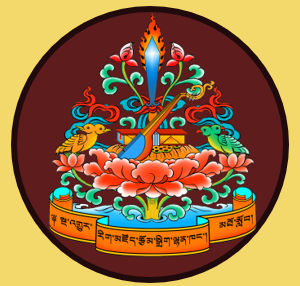Namo Buddha in Nepal is considered to be one of the sacred pilgrimage sites of Buddhism. According to the Jatakas and other sutras, this place is related to the profound deed of Prince Mahasattva, who was one of the former incarnations of Buddha Shakyamuni. The narrative goes like this:
Once there lived a powerful king called Maharatha. He had three sons: Dra Chenpo, La Chenpo and Semchen Chenpo. The youngest of the three was called Mahasattva (Tib. Semchen Chenpo). He was very compassionate and treated all the animals with kindness. One day the whole royal family went for a stroll accompanied by the ministers and armies. On the way they took a rest for a while, during which time the three princes went into the forest to play.
In the forest they saw a hungry tigress with a shrunken face that was feeding milk to her cubs in pain. She was thirsty and looked like she had not had a meal for a week. Seeing this, the prince Mahasattva said to his brothers, “She might eat her cubs out of starvation.” The two brothers agreed with him.
Then he asked, “What kind of food does a tigress eat?”
“Only fresh meat and blood would satisfy her,” they replied.
“Would it be possible to save her life without sacrificing another’s life?” the prince asked his brothers.
“It is impossible,” said the two.

The prince then went in deep thought. He considered, “I have been wandering in samsara for many eons. During all that time, my bodies would have been only used as the means to indulge in attachment, hatred, ignorance and so on. So, until now I haven’t used this body as a means to generate merit.”
After thinking in this way, he instantly decided to offer his precious body to the tigress. But first he wanted his brothers to leave, so he played a trick and said to his brothers that he had some important work to be done and sent them back. Then Prince Mahasattva directly entered the tigress’s den and laid in front of her. But the tigress had become so numb out of starvation that she could not eat him. So, he scratched his body with a sharp thorn and let his blood flow into her mouth. After some time, the tigress recovered and ate all the flesh of the brave prince.
Meanwhile, the two brothers were worried as their youngest brother had not returned even after a long period of time, so they went out to look for him. After a thorough search, they feared that he might have gone to the tigress’s den. Gathering their courage, they walked towards it. When they had reached near the den, they saw the leftover bones and hair of their brother covered in blood. The two brothers were breathless from shock and fainted on the ground.

At that time the queen had been sleeping. She dreamed of three pigeons flying high in the sky. She saw the beak of the youngest pigeon stained with blood. She suddenly woke up, panting hard in fear, and immediately shared her dream with the king. The king analysed it, took it to be a bad omen and ordered the armies to search for their princes.
After a long search, they found two elder princes. “Are you alright?” asked the king.
The two princes said after a long stammer, “Our beloved brother was eaten by a tigress.”
No sooner did the queen hear those words than she fainted on the ground. When she woke up, the king, princes, ministers, armies and she herself all ran towards the tigress’s den to see the dead body of their beloved prince. After reaching the den, they were shocked to see the leftover bones and hair of the prince covered in blood. Everybody present at the scene gave loud cries of sadness.

Meanwhile the prince had been reborn in the heaven called Joyous Land. With his clairvoyance, he saw his family members mourning over his death. He worried that it could hinder him in achieving realisation. So, with his supernatural power, he sent messages in the form of thunder. The king, queen, two princes and the country people heard beautiful words from the empty sky. The king and the queen were dismayed, and they looked up in the sky and said, “Oh god, why you are sending messages to us? What does this mean?”
“I am the prince Mahasattva,” he replied. “Because I offered my body to the tigress, I was born in the heaven called Joyous Land.” He then told them about the infallible nature of impermanence and the significance of Dharma practice.
After hearing these words, all the people including the royal family were relieved from their grief. They then built a memorial stupa to enshrine his leftover bones and hair. Since then Buddhists have considered this place to be sacred.
The natives of Nepal call the place Namo Buddha (“Homage to Buddha”). The Tibetans call it Takmo Lunjin (takmo means “tigress”; lu, “body”; and jin, “to give”) relating to the profound act of generosity by the prince.
Namo Buddha is located about 42 kilometers from Kathmandu, the capital of Nepal. One can take a local bus from Kathmandu or also trek from Banepa to Namo Buddha, passing through Panauti and Sangkhu.
By Rigzod Editors
NREC, 2018


